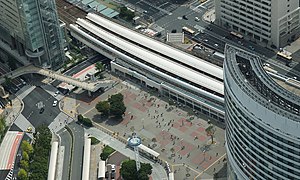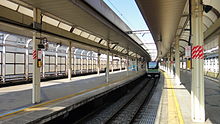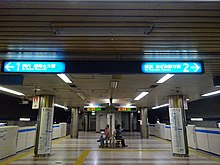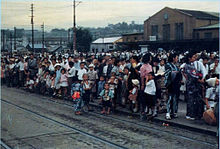Sakuragichō Station
| Sakuragichō ( 桜 木 町 ) | |
|---|---|
|
Top view (August 2014)
|
|
| Data | |
| Location in the network | Through station |
| Platform tracks | 3 (railway) 2 (subway) |
| abbreviation | JK11 / B18 |
| opening | June 12, 1872 |
| location | |
| City / municipality | Yokohama |
| prefecture | Kanagawa |
| Country | Japan |
| Coordinates | 35 ° 27 '3 " N , 139 ° 37' 52" E |
| Height ( SO ) | 3 m TP |
| Railway lines | |
| List of train stations in Japan | |
The Sakuragichō station ( Japanese 桜 木 町 駅 , Sakuragichō-eki ) is a train station on the Japanese island of Honshū . It is located in Kanagawa Prefecture in Yokohama City , more precisely in Naka-ku District . Sakuragichō is one of the oldest train stations in the country and was Yokohama's main train station from 1872 to 1915. Today it is a transfer hub between the railway and the Yokohama subway .
links
Sakuragichō is a through station and former terminus on the Negishi line , which is connected to the Keihin-Tōhoku line in the neighboring Yokohama station and runs through the southern districts of the city. Through local trains connect Ōmiya in Saitama prefecture with Tokyo , Shinagawa , Yokohama and Ōfuna . There is also a close connection between the Negishi line and the Yokohama line : on weekdays between 9 a.m. and 3 p.m. and on weekends between 9 a.m. and 5 p.m., three express trains per hour are offered, which run from Sakuragichō via Yokohama and Higashi-Kanagawa to Hachiōji ; there are also local trains from Sakuragichō to Hashimoto (during rush hour there are occasional trips from and to Ōfuna). This means that Sakuragichō is served by up to 14 trains per hour during the day during the day (up to ten in a southerly direction), and up to 20 (or 14) per hour during rush hour.
By the Association of the City Yokohama powered Blue Line subway runs from about 5:30 to 0:30, depending on the time of day seven to 13 times every hour. Next to the eastern station forecourt there is a bus station , from which more than 40 lines of the Tourist Office and the companies Fuji Express , Keikyū Bus , Kanagawa Chūō Kōtsū and Sōtetsu Bus operate. There are also six other lines from the Tourist Office and Fuji Express, which stop on the street in front of the west entrance.
investment
The station is in the middle of the central Sakuragichō district, which is part of the Naka-ku district. Nearby are the Minato Mirai 21 port district and numerous well-known attractions. These include the Harbor Museum, Nippon Maru Memorial Park , Nogeyama Zoo, Pacifico Yokohama , Yokohama Cosmo World, and the Yokohama Landmark Tower . The facility, located on a viaduct, is oriented from northwest to southeast and has three tracks, all of which are used for passenger traffic. They are located on two completely covered central platforms . On the inside they jointly open up the middle track in order to speed up the passenger switching time of the trains turning here ( Spanish solution ). Through traffic is handled on the outside of the platforms.
The middle track ends bluntly at the southern end of the layout . A little more than half a kilometer northwest of the station branches off the Takashima line, which is used exclusively for rail freight traffic. It is a branch line of the Tōkaidō freight line , opens up the port of Yokohama and leads to Tsurumi . The station building is located under the viaduct and is accessible from both sides; Stairs, elevators and escalators lead up to the platforms. The shopping center CIAL Sakuragichō , which belongs to a subsidiary of JR East and comprises 35 shops, is attached to the entrance building .
In front of the east side of the station there is an extensive, traffic-free area. From there, a covered moving walkway leads to the Landmark Tower. Since 1999, a pedestrian underpass has led to the Pio City shopping and leisure center ( ぴ お シ テ ィ ) under the adjacent Prefecture Street 16 to the west . Its third basement serves as a distribution level for the Sakuragichō subway station. One floor below, the Blue Line trains stop at a central platform equipped with platform screen doors.
In the 2018 fiscal year, an average of 110,084 passengers used the station every day. Of these, 71,160 were on JR East and 38,924 on the subway.
Tracks
- railroad
| 1 | ▉ Negishi line | Isogo • Ōfuna |
| 2 | ▉ Negishi line | (only to get off) |
| 3/4 | ▉ Keihin-Tōhoku line | Yokohama • Tokyo • Ōmiya |
| ▉ Yokohama Line | Yokohama • Machida • Hachiōji |
- Subway
| 1 | ▉ Blue line | Kamiōoka • Totsuka • Shōnandai |
| 2 | ▉ Blue line | Yokohama • Shin-Yokohama • Azamino |
history
The British engineer Edmund Morel began surveying Japan's first railway line in April 1870. He set Shimbashi in Tokyo and Sakuragichō in Yokohama as the endpoints of the 29 km long connection. At that time the station was located directly on the bank of Tokyo Bay and a railroad embankment cut off a side bay; only later did new districts emerge through land reclamation . The provisional commissioning of the designed by the American architect Richard Bridgens head station Yokohama took place on 12 June 1872 together with the stretch of Shinagawa . On October 14, 1872, Emperor Meiji officially opened the first part of what was later to be called the Tōkaidō main line , which now extended to Shimbashi. Freight traffic began on September 15, 1873. The state railway administration opened the section to Kōzu on July 11, 1887 . On August 31, 1898, a shortcut line was put into operation, so that numerous trains no longer turned in the terminus.
The opening of the electric Keihin line in December 1914 required a reorganization of rail traffic. At what is now Takashimachō subway station , a new central station was built, which went into operation on August 15, 1915. On the same day, the Yokohama terminus was named Sakuragichō . Freight traffic was discontinued on December 30, 1915 in order to create more space for suburban traffic on the Keihin Line , which was extended to this point on the same day . As a result of the Great Kanto earthquake on September 1, 1923, the station burned down completely. The new building that was then built was opened in 1927. A year later, Yokohama Central Station , which was also destroyed in the earthquake, moved to its current location, which is why the access to Sakuragichō had to be adapted. The private railway company Tōkyū Dentetsu extended the Tōyoko line from the previous end point Takashimachō to here on March 31, 1932 , but initially only on a single track. A second track was available from September 10, 1956.
On April 24, 1951, a serious accident occurred when a Keihin Line train entered the station, killing 105 people. A damaged section of overhead contact line got caught in the pantograph and triggered a fire on the train roof. In the first car it destroyed the compressed air opening mechanism of the doors, trapping the passengers (more on this in this article ). The Japanese State Railways converted the terminus in the early 1960s into a through station and opened the section between Sakuragichō and Isogo on May 19, 1964 . The Yokohama – Sakuragichō section was no longer part of the Tōkaidō main line and the Keihin-Tōhoku line, but was now part of the newly introduced Negishi line . With the opening of a branch line of the Takashima line in the port area on June 1 of the same year, freight trains returned to Sakuragicho after almost half a century.
The station was connected to the subway network when the municipal transport authority opened a section of the Blue Line between the Yokohama and Isezaki-Chōjamachi stations on September 4, 1976 . As part of the privatization of the state railways, the station became the property of the new company JR East on April 1, 1989 . This continued the new construction of the station that had previously been started and completed the work in 1989. The Tōkyū Dentetsu withdrew the Tōyoko line on January 30, 2004 from Sakuragichō and began two days later to direct their trains on the new Minatomirai line , which begins in Yokohama station. The city administration had the no longer needed viaduct of the Tōkyū Dentetsu redesigned into an urban green area and opened it to the public between 2006 and 2011 as the Tōyoko Flower Green Road . In place of the former Tōkyū train station, the CIAL Sakuragichō shopping center was built and opened its doors on July 16, 2014.
Adjacent train stations
|
←
|
Lines |
→
|
||
|---|---|---|---|---|
| Yokohama |
|
Kannai | ||
| Takashimacho |
|
Kannai | ||
| Takashimacho |
Tōkyū Dentetsu (1932-2004) |
The End | ||
Web links
- JR East Station Information (Japanese)
- Yokohama Subway Station Information (Japanese)
Individual evidence
- ↑ JR 時刻表 2019 年 3 月 号 (JR timetable March 2019). Kōtsū shinbunsha, Tokyo 2019.
- ↑ Weekday schedule in the direction of Yokohama. JR East , 2020, accessed May 21, 2020 .
- ↑ Floor guide. CIAL Sakuragichō, accessed on May 21, 2020 (English).
- ↑ 各 駅 の 乗車 人員. JR East , 2018, accessed May 22, 2020 (Japanese).
- ↑ 横 浜 市 統計 書 第 9 章 道路 、 運輸 及 び 通信. Yokohama City, 2019, accessed May 22, 2020 (Japanese).
- ^ Dan Free: Early Japanese Railways 1853-1914: Engineering Triumphs That Transformed Meiji-era Japan . Turtle Publishing, Clarendon 2014, ISBN 978-4-8053-1290-2 , pp. 63-64 .
- ^ Dan Free: Early Japanese Railways 1853-1914. Pp. 77-80.
- ^ Dan Free: Early Japanese Railways 1853-1914. P. 84.
- ↑ a b 横 浜 の 鉄 道: そ の 歴 史 . In: 調査 季報 . tape 121 . Yokohama City Council, Yokohama 1994, p. 44-52 .
- ↑ 東京 急 行 電 鉄 50 年 史 . Tōkyū Dentetsu , Shibuya 1973, p. 117-118 .
- ↑ 東京 急 行 電 鉄 50 年 史, pp. 456–458.
- ↑ Train fire at Sakuragichō. Failure Knowledge Database, accessed May 21, 2020 .
- ↑ a b Tetsu Ishino (Ed.): 停車場 変 遷 大事 典 国 鉄 ・ JR 編 (station change directory JNR / JR) . JTB, Tokyo 1998, ISBN 978-4-533-02980-6 .
- ↑ Yokohama. urbanrail.net, 2011, accessed on May 21, 2020 (English).
- ↑ 東 横線 と み な と み ら い 21 線 と の 相互 直通 運 転 開始 に 伴 う 東 横線 横 横 浜 〜 桜 木 町 間 の 廃 止 に つ い て. (PDF, 18 kB) Tōkyū Dentetsu, January 30, 2003, archived from the original on April 14, 2015 ; Retrieved May 21, 2020 (Japanese).
- ↑ 東 急 東 横線 の 跡 地 利用. Yokohama City, March 14, 2019, accessed May 21, 2020 (Japanese).
- ↑ 「駅 と 街 一体 に」 CIAL 桜 木 町 オ ー プ ン. Kanagawa Shimbun, July 17, 2014, accessed May 21, 2020 (Japanese).






